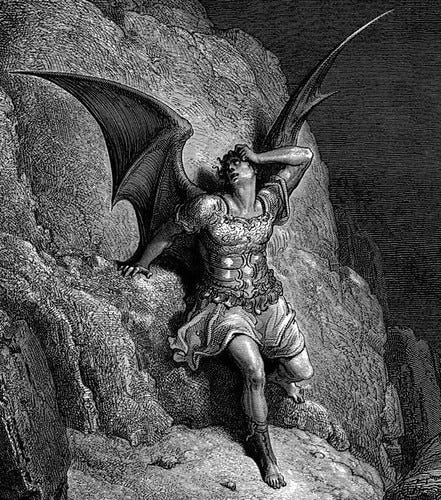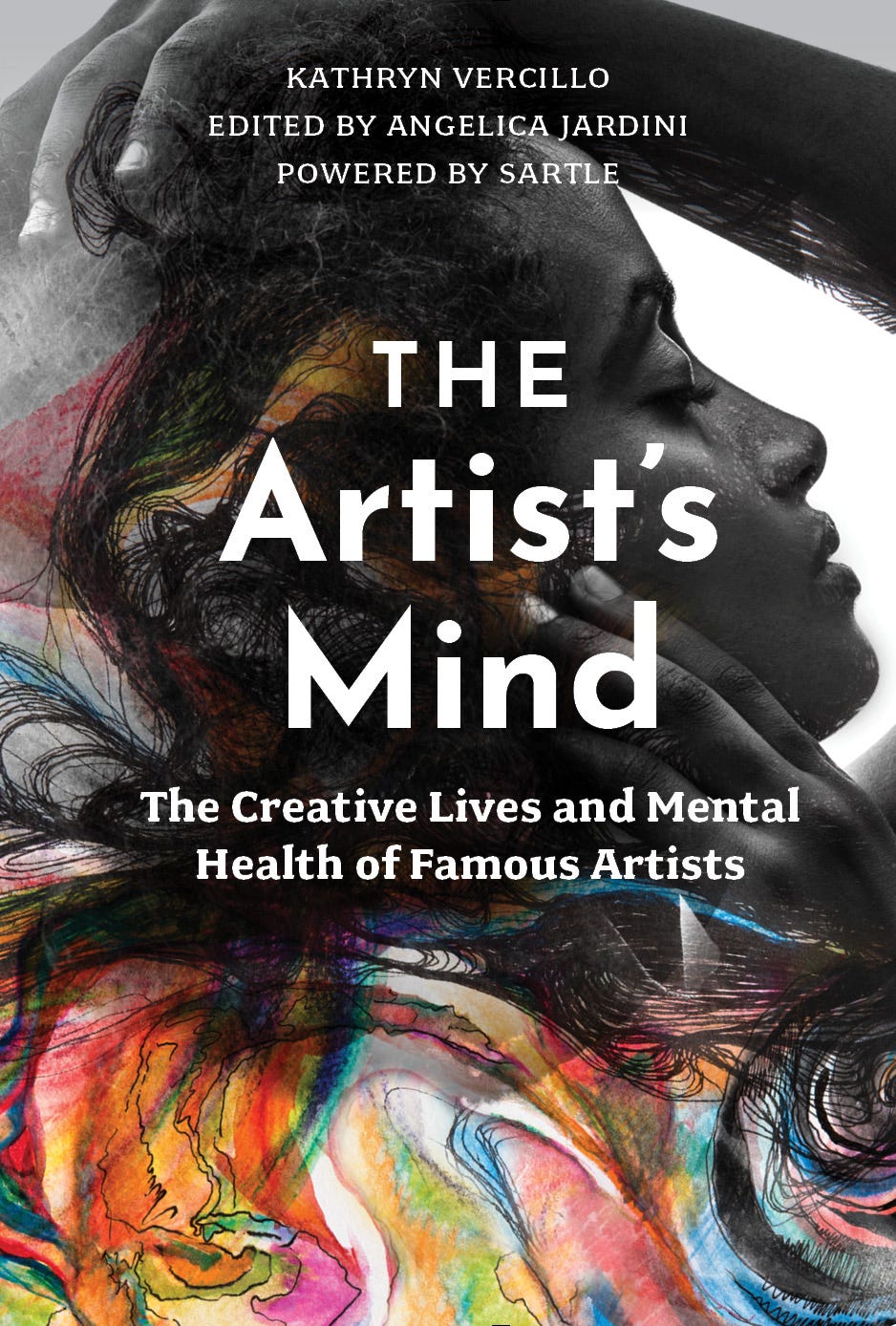9 Mental Health Lessons from Famous Artists
What can famous artists teach us about mental health? Multitudes.
In 2023, this newsletter kicked off the month-long virtual book tour for The Artist’s Mind: The Creative Lives and Mental Health of Famous Artists. In it I share a little bit more about the book, offer two mental health lessons from my art history research, and tell you where to find the first stop on the tour.
What Is The Artist’s Mind?
The Artist’s Mind is a book that explores the intersection of mental health and creativity by telling the life stories of famous artists. Taking into account historical and cultural context, it showcases how mental health issues such as depression, anxiety, trauma, and schizophrenia influenced some of the world's most beloved artists in order to destigmatize mental illness in popular culture and inspire creativity in anyone who may be experiencing similar problems.
This book is unique in the way in which it melds psychology with art historical analysis, exploring how an artist's mental health directly impacts their creative process, and how these struggles might manifest in the artwork itself. Readers will also gain an understanding about how the treatment of psychological disorders has evolved over time, and how an individual's experience (and status in the art historical canon) is directly affected by world events, race, gender, and socioeconomic status.
Virtual Book Tour: Hey, YA
The first stop on the virtual book tour was a guest post over at Hey, YA by
, the name of which has since been changed to Just Between You & Me …Jodie is an Australian author, psychologist, TEDx speaker and wellbeing specialist who says:
“I sit in the intersection between psychology and creativity and my mission is to place healing at the heart of storytelling so we can all live an intentional, reflective, creative life.”
This is directly in line with what I do, exploring the complex relationship between art and mental health in the hopes of starting deep conversations that help other creatives achieve the version of creative and financial and holistic wellness that works for them. So, I was thrilled to write a guest post for her readers.
Mental Health Lessons From the Artist’s Mind

In my guest post for Jodie, I shared seven of the mental health lessons that you might learn from reading about the artists in The Artist’s Mind. Here are two more in addition to the seven I shared there:
1. Your challenges are likely both individual and societal; your art may reflect this.
You may have specific mental health symptoms or challenges. However, you do not exist in a vacuum. You exist in a time and place in society that impacts you on many levels. This influences your art and it influences your mental health.
Gustave Dore provides an example of someone who experienced depression while also living amongst misère, which “is poverty-induced depression that impacts people living in industrial nations when they have to co-exist aside great wealth.” His work was both a form of self-expression and a form of social commentary. When you go to the doctor and get a depression diagnosis, the diagnosis is unique to you. However, a lot of people might also experience depression at the same time. In Dore’s time, the poverty in London that created misère was a cause; in our time, COVID might have been another example.
One of Doré’s works that is especially relevant to today is Bulls-eye. The artist uses light and shadow to dramatically capture the unfair distribution of power between policemen and a group of people in poverty. The officers wield bright lights while the impoverished are stuck in their glare. It’s a familiar issue - the misère of 19th century London reflected in this work mirrors 21st century conflicts that people of color and other oppressed groups face in regards to policing and prison today.
Notably, as an artist working through his own depression as well as through the more widespread feeling of misère, Doré’s work often resonates with others coping with similar struggles. His works are frequently cited in books about the experience of depression. For example, William Styron’s memoir, “Darkness Visible: A Memoir of Madness,” which is noted for raising awareness about depression, drew its title from John Milton’s Paradise Lost, which was illustrated by Doré. More recently, Mary Cregan’s memoir The Scar: A Personal History of Depression and Recovery expresses: “I felt as though I were in the midst of Hell as drawn by Gustave Doré for Dante's Divine Comedy.” Artists in all mediums have been drawn to his work. In film, his characters inspired George Lucas’s Chewbacca, Shrek’s Puss in Boots, and the first movie version of Beauty and the Beast. And perhaps most notably of all artists, Vincent Van Gogh recognized the masterful work of Doré. In fact, “Van Gogh copied Prisoners’ Round by Gustave Doré … from a print of Newgate Prison, London.” One might naturally wonder if he was drawn to Doré’s work, at least in part, because of the depression they had in common.
Many other artists clearly experienced social challenges and trauma from events like war in addition to their own individual psyche’s challenges. Leonora Carrington would be another example from the book.

2. You can live a long, creative life even with recurring mental health challenges.
Oftentimes discussions about artists with depression or schizophrenia or other challenging conditions are centered around the artists we lost at a young age, usually to drugs or suicide. That does happen, but that’s not the only story.
There are many famous artists who lived with really challenging mental health issues but continued creating well into their seventh and eighth decades of life. Joan Miro and Alice Neel are just two examples of artists from the book who had ongoing depression but lived full, creative lives.
Neel lived to age 84. However, in her older years, she described herself as having been suicidal for most of her life. We can’t underestimate the struggle that she went through to live with that feeling all the way to the age of 84. Moreover, we can’t underestimate the potential power that art played in assisting her to make it through those challenging times. She named it herself.
In a documentary made by her grandson, a family member makes a critical point: Alice Neel became a famous artist, and therefore the world, and perhaps the artist herself, considered her suffering “worth it?” But if she had never become famous, as is the lot of many, many artists with and without mental health challenges, does that mean it’s not “worth it?” Her own son recalls that before his mother was financially successful as an artist, they would often live on government assistance, which she was as likely to spend on art supplies as on food. He further says that he believes that “bohemian culture” hurts a lot of innocent people, himself included. But who is to say whether or not the suffering was worth it, whether or not the art makes it worth it; perhaps Alice Neel herself had no other choice and so she did what she could to make the best life possible and in the process gave the world her art.
Although you can live a long creative life with recurring mental health challenges, it’s important to note that having a diagnosis isn’t necessarily a lifelong thing, something I discuss further, along with other lessons, in the guest post over on Jodie’s page.
Art and Mental Health Takeaways:
In summary from the above article:
Art is therapeutic and cathartic, but there is a more nuanced relationship between art and mental health for famous artists throughout history and for all of us creatives.
When we talk about mental health, we mean a variety of different things beyond just a “diagnosis.” Our individual mental health exists alongside what is also happening in our lives and in the society around us.
Storytelling can offer healing.
The work an artist creates from a place of depression or struggle or hardship can potentially resonate deeply with many people including impacting the work of other artists.
You can live a very long and fulfilling life as a creative person with serious mental health challenges. Art can be a key part of what makes it fulfilling enough to keep going. But there may be a cost, and that’s worth at least having a discussion about.
One of the things that I’m trying to puzzle through is how to make clear that even though I’ve written a whole book on this topic, this book is just the tippy top of the iceberg of the conversation I want to be having. I don’t have “answers” but rather have a lot of questions and a few ideas about how mental health and creativity are related.
The question is complicated enough but then when we add in what’s also going on in the greater society, it gets even more complicated. There’s that saying about how you’re not paranoid if they’re really out to get you and even though it makes for a cheesy bumper sticker or t-shirt slogan the underlying point can’t be denied - what’s in your mind is unique to you but is also inevitably shaped by what’s going on around you.
And then there’s the conversation about whether or not the art is “worth it” or in what way? If someone’s deep depression leads to amazing creativity that’s also a helpful statement on society and may even add to creating social change … is that “worth” the challenges of living with that condition? Perhaps the artist would have that experience either way so the art becomes why it’s worth it. But what about in cases where the artist might have other tools for well-being and creating the art actually makes things worse for them? Is it still worth it?
Whenever I try to write about this complexity, I get a little overwhelmed by how inarticulate I feel. There’s a lot here to parse through. As much as I’ve learned, I have so much more to learn.
Art and Journal Prompts:
I offer you some creativity prompts that you can use for journaling, creative writing, as a start to an art project, or however you may see fit.
Create a timeline of the key events in your life from birth to now, including milestones related to your creativity and your mental health. Then add in a timeline of family, local, regional, and global events that occurred at the same time. What conclusions might you draw from the results?
What are the most challenging things you’ve experienced in terms of how creating art or trying to sell art or getting feedback on your creativity impacts your mental health? Explore the ways in which it was still “worth it” or necessary for you to create.
Write a journal entry from the perspective of a famous artist, exploring their thoughts and emotions while creating a significant artwork. What struggles and triumphs did they experience during this process?
Freewrite about: What societal issues or challenges resonate deeply with you, and how can you use your art to address or comment on them?
What role does storytelling play in your life, and how can it be a source of healing and understanding for both yourself and others?
Reflecting on famous artists who lived with mental health challenges throughout their lives, how do you envision your own creative journey in the long term?
Related Tips for Using Creativity to Improve Wellness:
In addition to the above prompts, you might want to try some of these creative activities to help improve mental health:
Create an artwork that addresses a current social or political issue that deeply affects you. How does your mental health perspective shape the way you approach this topic? How does creating the piece make you feel?
Start an art journal where you can combine writing, drawing, and collage to explore your emotions, thoughts, and experiences. This creative journaling can provide valuable insights into your mental and emotional well-being.
Decorate your living or working space with art that resonates with you and inspires the feelings that you most want to experience.
Related Tips for Coping with Mental Health Symptoms That Impact Creativity:
Do you have symptoms that are impacting your ability to create? Here are some additional wellness tips:
Volunteer for causes that you care about. Taking action can sometimes help reduce the mental strain of the issues that stress us.
Utilize art to raise awareness about mental health issues and advocate for positive change. Use your creative platform to spread messages of hope, understanding, and empathy.
Research a contemporary artist who uses their art to advocate for mental health awareness or social change. What can you learn from them that might enhance your own wellness as an artist and human?
Consider engaging in formal art therapy sessions if you find that you need professional guidance to explore your emotions and mental health through art.
Affirmations, Quotes, Meditations, Etc.:
Reading or writing affirmations / mantras can be very powerful. In relation to this article, play around with writing them down (I usually do ten times each for the one I’m working with) and then with simply thinking them or reciting them out loud and see what feels best for you.
I live an intentional, reflective, creative life.
Storytelling is at the heart of healing.
I look forward to a long, creative life.
My art reflects both my individual struggles and the world's complexities.
My art connects me to a larger narrative.
I honor my journey through transformative art.
My art is worth it. My life is worth it.
Through art, I connect with others' experiences.
My creativity reflects my values.
And a thought from Alice Neel: “Nobody knows what makes good art. As an artist, when it happens, you’re grateful, and then you get on with it.”
If you read this far, perhaps you liked the work. The work does take work. It only continues with support, so please consider subscribing. My annual rate starts at $10 per year.








